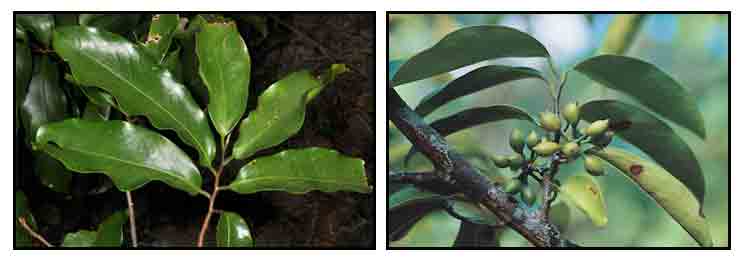
Botany
Amuyon is a small tree. Leaves are smooth, oblong, 15 to 25 centimeters long and about 5 centimeters wide, and pointed at both ends. Flowers are yellowish green, borne on the sides or at the axils of the leaves, nodding, upon 1-centimeter-long pedicels. Sepals are smooth and pointed. Outer petals are lanceolate, 3 to 5 centimeters long; the inner one are scarcely half as long. Fruit is smooth, cylindrically elongated or sausage-like, about 3 centimeters long, containing one to three seeds.
 Distribution Distribution
- Found in forests at low and medium altitudes in Abra, Ilocos Norte, Ilocos Sur, Pangasinan, Batangas, Rizal, and Quezon Provinces in Luzon; in Negros, Bohol and Mindanao.
- Also reported in Taiwan.
Constituents
- Phytochemical screening yielded five isoquinoline alkaloids.
- Study of stems yielded two new compounds, goniothalesacetate (1) and goniothalesdiol A (2) together with goniodiol-7-monoacetate, goniodiol-8-monoacetate, leiocarpin C, liriodenine, griffithazanone A, 4-methyl-2,9,10-(2H)-1-azaanthracencetrione, velutinam and aristolactam BII. (3)
- Study of stems yielded two new compounds, goniothalesacetate (1) and goniothalesdiol A (2), along with goniodiol-7-monoacetate, goniodiol-8-monoacetate, leiocarpin C, liriodenine, griffithazanone A, 4-methyl-2,9,10-(2H)-1-azaanthracencetrione, velutinam, and aristolactam BII. (12)
- Study of leaves and stems yielded two new styrylpyrones, (6R,7R,8R)-8-methoxygoniodiol (1) and (6R,7R,8R)-8-chlorogoniodiol (2), along with seven known styrylpyrones and eight other known compounds. (see study below) (2)
Properties
- Stomachic, antitumor, anti-scabies.
- Studies have shown antibacterial, cytotoxic, anti-cancer properties.
Parts used
Seeds, fruit.
Uses
Folkloric
- The Ayta communities in Dinalupihan, Bataan, Philippines, apply plant extracts or pounded stems mixed with oil to arthritis or areas of body pain. (13)
-
Seeds, cooked with oil, used as liniment for rheumatic complaints.
- Decoction of seeds used for tympanites.
- Fruit used as stomachic.
- In Taiwan, extracts of seeds used for treatment of edema and rheumatism. Seeds also used for treatment of scabies.
Others
- Rope: Bark of the plant yields an apricot-buff colored bast fiber which is used for making rope. Rope is somewhat weak, with a tensile strength of 345 kilos per square cm, reduced by 15% when wet.
Studies
• Cytotoxicity / Anti-tumor: Study isolated styrylpyrone, goniodiol-7-monoacetate, which showed potent cytotoxicities against KB, P-388, RPMI and TE671 tumor cells. (1)
• Cytotoxic Styrylpyrones / Anticancer / Leaves and Stems: Study of leaves and stems yielded two new styrylpyrones, (6R,7R,8R)-8-methoxygoniodiol and (6R,7R,8R)-8-chlorogoniodiol, together with seven known styrylpyrones and eight other known compounds. Compound 2 showed significant selective cytotoxicity toward the HONE-1 cancer cell line. (2)
• Three New Styryllactones / Cytotoxicity Against HepG2 Cancer Cell Line: Study of aerial parts yielded three new styrylpyrone analogues, digoniodiol (2), deoxygoniopypyrone A (3), and goniofupyrone A (4), along with ten known styryllactones. Goniothalamin, goniothalamin epoxide, and 8-chlorogoniodiol showed significant cytotoxicity against the HepG2 cancer cell line and moderate toxicity toward Hep3B, MDA-MB-231, and MCF-7 cancer cell lines. (8)
• Goniothalamin: Goniothalamin (GTN) is a natural compound that has shown to be cytotoxic to a variety of tumor cell lines including breast, blood, ovary, lung, kidney, prostate, hepatoblast and colon. (1) Study isolated goniothalamin (GTN) from G. amuyon. Results showed goniothalamin induced apoptosis in HCC (hepatocellular carcinoma) derived cells through distinct signaling pathways. (4)
• Anti-Lung Cancer: Study investigated the anticancer activities of GTN against human lung cancer using non-small cell lung cancer cell line. GTN exhibited significant inhibition of cellular proliferation. The DNA-damaging effect of GTN against lung cancer cells leads to growth inhibition and depression in migration ability. Results suggest GTN has potential as a chemotherapeutic agent against lung cancer.
• Goniothalamin / Noxa-mediated Apoptosis / Anti-Hepatocellular Cancer: Study showed GTN triggered phorbol-12-myristate-13-acetate-induced protein 1 (PMAIP1, also known as NOXA)-mediated apoptosis via TP53-dependent and -independent pathways. GTN might represent a novel anticancer drug that induces apoptosis in HCC-derived cells through PMA1P1 transactivation. (9)
Availability
Wild-crafted.
|

![]()




 Distribution
Distribution